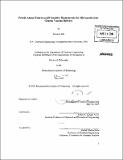Poly ([beta]-amino ester)s as pH sensitive biomaterials for microparticulate genetic vaccine delivery
Author(s)
Little, Steven (Steven Ronald)
DownloadFull printable version (20.36Mb)
Other Contributors
Massachusetts Institute of Technology. Dept. of Chemical Engineering.
Advisor
Robert S. Langer.
Terms of use
Metadata
Show full item recordAbstract
Genetic vaccination is the administration of nucleic acids to induce cellular expression of antigens, leading to an immune response. Unlike traditional vaccines, this technology has tremendous potential for treating or preventing diseases such as HIV, malaria, and cancer. However, this potential is currently unrealized because of the safety concerns which plague viral vaccine carriers and the inefficiency of nonviral delivery systems when compared to their viral counterparts. A promising and versatile nonviral delivery method for genetic vaccines involves microencapsulation of antigen-encoding DNA, because such particles protect their payload and target it to phagocytic, antigen-presenting immune cells. However, the biomaterial conventionally used in these microparticle formulations, an FDA-approved polyester called poly lactic-co-glycolic acid (PLGA), was not designed specifically to deliver DNA, takes too long to release encapsulated payload, and therefore fails to induce high levels of target gene expression. A new class of novel biomaterials have been synthesized called poly([beta]-amino ester)s which are biodegradable and can have similar physical properties to PLGA, but are pH-sensitive and have gene delivery functionalities. (cont.) Using these materials we can fabricate microparticle-based delivery systems which have relatively high DNA loadings and can significantly buffer the destructive acidic pH microenvironment created by ester bond degradation. These formulations generate an increase of up to 5 orders of magnitude in DNA delivery efficiency when compared to PLGA alone and can be potent stimulators of antigen presenting cells in vitro. We have also demonstrated that incorporating these new biomaterials into microparticulate genetic vaccines can lead to antigen-specific, immune-mediated rejection of a lethal tumor dosage in vivo, a significant advance over conventional formulations. Finally, with the synthesis of libraries containing thousands of structurally diverse PBAEs, it is warranted to develop new methods of fabrication which enable the high-throughput screening of such libraries. Herein, we describe, for the first time, such a rapid fabrication technique and demonstrate that plasmid encapsulated in these formulations is transcriptionally active.
Description
Thesis (Ph. D.)--Massachusetts Institute of Technology, Dept. of Chemical Engineering, 2005. In title on t.p., "beta" appears as lower-case Greek letter. Includes bibliographical references.
Date issued
2005Department
Massachusetts Institute of Technology. Department of Chemical EngineeringPublisher
Massachusetts Institute of Technology
Keywords
Chemical Engineering.